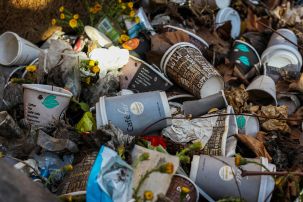Lesson summary
In this activity students map the distribution and composition of litter in the school courtyards and grounds. Students work in groups to count the number of litter items across the school. Groups then come together to compile their information to create a complete picture of litter at your school.
Completing this litter audit gathers the baseline litter data for the school. This audit activity should be conducted again after some litter reduction activities have been put in place in the school, so that changes in the amount and location of litter can be measured and reported on.
Learning intentions:
Students will...
- recognise that litter can be found to varying degrees in schools and the environment in general.
- recognise that litter has many negative impacts for people and animals in the environment, and can have impacts far away from the school site.
- understand that reducing litter can have many benefits for the school community and the environment in general.
Lesson guides and printables
Curriculum links
Select your curriculum from the options below.
Lesson details
Curriculum mapping
Australian Curriculum content descriptions:
Science Year 7:
- Some of Earth’s resources are renewable, but others are non-renewable (ACSSU116)
Geography Year 7:
- Collect, select and record relevant geographical data and information, using ethical protocols, from appropriate primary and secondary sources (ACHGS048)
- Reflect on their learning to propose individual and collective action in response to a contemporary geographical challenge, taking account of environmental, economic and social considerations, and predict the expected outcomes of their proposal (ACHGS054)
Mathematics Year 7:
- Find percentages of quantities and express one quantity as a percentage of another, with and without digital technologies. (ACMNA158)
Science Year 8:
- Science and technology contribute to finding solutions to a range of contemporary issues; these solutions may impact on other areas of society and involve ethical considerations (ACSHE135)
Geography Year 8:
- Collect, select and record relevant geographical data and information, using ethical protocols, from appropriate primary and secondary sources (ACHGS056)
- Reflect on their learning to propose individual and collective action in response to a contemporary geographical challenge, taking account of environmental, economic and social considerations, and predict the expected outcomes of their proposal (ACHGS062)
Mathematics Year 8:
- Solve problems involving the use of percentages, including percentage increases and decreases, with and without digital technologies (ACMNA187)
Geography Year 9:
- Collect, select, record and organise relevant geographical data and information, using ethical protocols, from a range of appropriate primary and secondary sources (ACHGS064)
Geography Year 10:
- Collect, select, record and organise relevant data and geographical information, using ethical protocols, from a range of appropriate primary and secondary sources (ACHGS073)
Cross curriculum priorities:
Sustainability – OI.5 – World views are formed by experiences at personal, local, national and global levels, and are linked to individual and community actions for sustainability.
General capabilities:
Numeracy, Critical and creative thinking
Syllabus Outcomes: GE4-7, GE4-8, GE5-7, SC4-11PW, SC4-12ES.
Connecting lessons: Waste audit – must be completed as a compulsory action.
Resources required
- Map of the school grounds
- student worksheet
- clip board (if using printed copies of worksheet)
- camera/smart phone or iPad for photographing litter.
Optional: bag or bin for collecting the litter items to put into a rubbish or recycling bin.
Additional info
This lesson can be used when working on the Waste Module of ResourceSmart AuSSI Vic Certification. By completing this lesson you will have completed the following actions:
Compulsory Actions:
- A1 – Have you undertaken litter assessments at your school?
- A1 – Has this data been entered as your baseline, and any anomalies explained?
Checklist data goals:
- No official data goal.


Welcome back!
Don't have an account yet?
Log in with:
Create your free Cool.org account.
Many of our resources are free, with an option to upgrade to Cool+ for premium content.
Already have an account?
Sign up with:
By signing up you accept Cool.org's Terms and Conditions(Opens in new tab) and Privacy Policy(Opens in new tab).